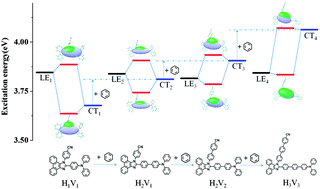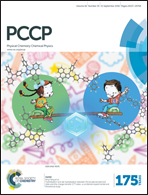Hybridization and de-hybridization between the locally-excited (LE) state and the charge-transfer (CT) state: a combined experimental and theoretical study†
Abstract
Excited state properties play a key role in the photoluminescence (PL) and electroluminescence (EL) performance of organic light-emitting diode (OLED) materials. The solvatochromic effects were observed in a series of triphenylamine (TPA)–phenanthroimidazole (PI) derivatives with the increase of solvent polarity, accompanied by the transformation of an excited state character from the locally-excited (LE) state to the charge-transfer (CT) state in the emission spectra. The excited state properties were systematically investigated in these donor–acceptor systems using time-dependent density functional theory (TD-DFT). The hybridization and de-hybridization processes between LE and CT states were resolved with an increasing number of phenyls along horizontal and vertical directions, respectively. We provide a novel insight into the fine modulation of the excited-state characters and compositions in the donor–acceptor system for the new-generation, low-cost and high-efficiency fluorescent OLED materials.


 Please wait while we load your content...
Please wait while we load your content...